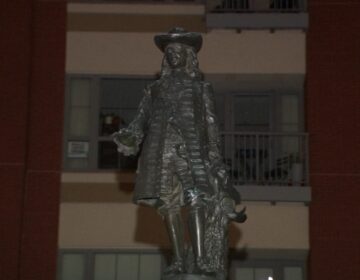Examining Ed Bacon’s Visions for Philadelphia
UC Review: Examining Ed Bacon’s Visions for Philadelphia
It’s hard to imagine how the “things that might have been” would impact the present.
If for instance, a World’s Fair had been hosted in Philadelphia to coincide with its 1976 Bicentennial celebration, would it have dramatically altered the city we inhabit today?
Would that city more closely resemble the vision of Philadelphia’s iconoclastic Edmund Bacon, the Planning Commission’s Executive Director from 1949-1970. Bacon’s vision of Philadelphia for example included creating a world class, vibrant downtown that re-attracted the middle class; a metropolis of neighborhood’s with mixed ethnicities but no racial tensions and perhaps most idealistically: as a post-petroleum city- a Philadelphia without cars.
The impact of Bacon’s visions, both realized and unrealized were discussed in a panel discussion format at the Penn Bookstore last Wednesday, February 17th by Scott Knowles, Gregg Heller and Harris Steinberg. Knowles, Heller and Steinberg, were among the authors that contributed to Imagining Philadelphia, which takes an essay Bacon wrote in 1959 entitled, “Philadelphia in the Year 2009,” for the Greater Philadelphia Magazine and compares what could have been with what is to what was and what could still be.
“Bacon wanted to put Philadelphia back on map,” explained Knowles, who teaches at Drexel University and also edited Imagining Philadelphia, for why he thinks Bacon wanted the city to host a World’s Fair. “This was due in part to the city’s decline as an industrial base,” Knowles continued.
Because, as Knowles explained, the Federal government had to name Philadelphia as a hosting city, plans for the 1976 World’s Fair/Bicentennial Celebration began with the formation of a Bicentennial Commission in the 60’s.
“The public immediately sniffed this out as a patronage gig,” said Knowles, explaining that the “failure of urban renewal was already known at that time.”
There were concerns, continued Knowles, “that neighborhoods like Mantua would be claimed as ‘eminent domain,’” and its buildings would be gutted to make room for parking lots for the fair.
The Young Professionals was then formed to develop plans. But every neighborhood association in the city opposed hosting a World’s Fair in their neighborhood, arguing that high-rise housing projects would be constructed in the Fair’s grounds when it ended. The neighborhood protests overlapped a Mayoral election, and Frank Rizzo Sr., said Knowles, supported the opposition.
The World’s Fair then shut down in 1972 after Nixon, who in realizing he didn’t need PA to win the Presidency never spoke to the any of its planners again, Knowles added.
“This period of Philadelphia’s history so important because so many people don’t know anything about it,” said Heller, President of the Bacon Foundation and author of the Book, Ed Bacon as well as Manager of the Community Development Corporation in Philadelphia.
Bacon, for instance took over the Planning Commission only a few years after it had formed, said Heller, explaining that prior to that point, the city’s planning apparatus, with no staff or budget was ineffective to say the least.
When Bacon was put on the cover of Time Magazine in 1964, he was a household name, Heller continued as result of the city’s redevelopment projects such as those in Society Hill and Penn Center.
“But Bacon,” said Heller, actually had a very limited role. For instance, Bacon was very vocally opposed the way Penn Center was designed.
“It was more of his salesmanship of ideas,” said Heller adding, “He was a brilliant public speaker. Other planners at that time either didn’t have those skills or didn’t think it was necessary to showcase them.”
One of the things Bacon spoke out against was the construction of high-rise tenements, “which he despised,” Heller explained. “He focused more on preservation.”
When looking at Bacon’s ultimate legacy, Steinberg, who’s President of Penn Praxis and is deeply involved in the Waterfront Redevelopment Plan refers to it as a “It’s a mixed one.”
“While Bacon was laying the groundwork for Philadelphia to become an anti- car city, there was the groundwork for I-95 and 676.”
Then again, said Steinberg, “there was also Society Hill and Pennypack Park.” And after Bacon left the Planning Commission, “there has been a loss of faith in Planning.”
Since Bacon left, Steinberg explained other groups emerged to fill the planning vacuum. They are: the Philadelphia Greens, formed in the 1970’s, which created the city’s public gardens, the Mural Arts program which reclaimed the city’s vacant lots and the Center City District, breathed life back into its night life, “which until the 1990’s rolled up its carpet at 5 p.m.”
Then by early 2000, Penn Praxis- an outreach arm of Penn’s School of Design- was formed, said Steinberg explaining that, “it didn’t want to see anymore deal making behind closed doors.”
“But then in the dead of night was the gaming rights bill, which put two casinos in Philadelphia,” continued Steinberg adding that Fumo then drafted “legislation to make sure we would not be able to determine the casinos locations.”
As for how this pertains to the seven-mile stretch from Alleghany to Oregon Ave, while much of the land will fall into the hands of private development, Steinberg discussed the 200 community meetings with 4,000 participants that led to its redevelopment plan. That includes, extending certain streets to the river, adding 3,000 acres of parklands, as well as making Pier 11 a Public Park.
While the Philadelphia of 2010 may not to live up to all of Bacon’s expectations, Heller argues that he would have been pleased to see the reemergence of a middle class downtown.
And as for what Philadelphia will look like in the next fifty years, Steinberg’s chapter is devoted to just that. “But I’m not going to tell you about that now,” he quipped at last week’s reading, “you have to buy the book.”
WHYY is your source for fact-based, in-depth journalism and information. As a nonprofit organization, we rely on financial support from readers like you. Please give today.





